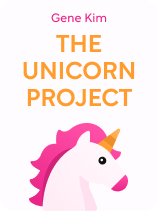

This article is an excerpt from the Shortform book guide to "The Unicorn Project" by Gene Kim. Shortform has the world's best summaries and analyses of books you should be reading.
Like this article? Sign up for a free trial here.
What is the book The Unicorn Project by Gene Kim about? How can employee autonomy make or break a company?
In The Unicorn Project, Gene Kim presents a fictional case study of a business that falls behind its competitors because of its soul-crushing work conditions. The result is a band of rebellious employees to figure out a new, more productive way of working.
Read below for a brief The Unicorn Project book overview to get the main ideas.
The Unicorn Project by Gene Kim
A modern company lives or dies by the efforts of the people it employs, and even a successful, long-lasting business can be undone by a toxic workplace culture. In The Unicorn Project book, published in 2019, Gene Kim argues that an organization is doomed if it fails to trust and empower its employees, focuses on assigning blame rather than solving problems, and stops anything from being accomplished by drowning every action in a mound of red tape. Once a business develops this kind of culture, it can either turn itself around or fade into irrelevance as rival companies outstrip it in the market.
The Unicorn Project presents a fictional case study of Parts Unlimited, a once-mighty auto parts manufacturer that’s fallen behind the times and its competitors, mainly because of the soul-crushing work conditions it’s allowed to develop in its IT department. When a technological initiative that’s crucial to the company’s success turns into a disaster, Parts Unlimited almost collapses until a band of rebellious programmers figure out a new, more productive way of working and put it into motion behind their executives’ backs.
Kim is the founder of the digital security company Tripwire, cofounder of the IT Process Institute, and a vocal proponent of the DevOps software development model. In 2013’s The Phoenix Project, written with coauthors Kevin Behr and George Spafford, Kim told the story of Parts Unlimited from the perspective of a company executive as he rescued its faltering IT department by better managing its production workflow. In The Unicorn Project, Kim tells the same story from a software developer’s point of view to highlight the characteristics of a healthy, creative workplace and what can be done to shift a company’s culture.
The Impossible Project
Kim’s narrative follows the story of Maxine Chambers, a lead developer in Parts Unlimited’s software development department within IT. Through Maxine’s eyes, Kim illustrates the characteristics of both unproductive and healthy workplace cultures, with an emphasis on how the former can be turned into the latter. In the story, Maxine goes from the frustration of being part of an ineffective department to joining a group of company rebels who secretly work to institute better practices, eventually setting an example for the rest of the company to follow.
Our story begins as Maxine finds out she’s been unjustly blamed for a payroll system failure. As punishment, she’s exiled to work on an online sales tool called the Phoenix Project that everyone in IT despises. Though management considers the Phoenix Project essential to dragging Parts Unlimited into the digital age, it’s been stuck in development hell for years. When Maxine arrives at her new workplace, the situation is even worse than she’d imagined.
The Phoenix Project office is a dismal cube farm where developers work in isolation from each other. The culture is one in which there’s no feedback, no visible progress, and no risks taken to foster innovation because people fear they’ll be punished if something goes wrong. While programmers develop separate Phoenix features, there’s no standard environment for developers to work in, no way to test the code they write, and no Phoenix documentation to help newcomers begin. Maxine’s initial task is to write that documentation, but she finds it impossible to even install a pre-release version of Phoenix on her laptop.
At a company meeting, the CEO announces that there will be no further delays in rolling the Phoenix Project out for the public—despite the fact that there hasn’t been a single successful test of the system. Everyone in IT knows that in its current state, Phoenix can’t possibly work, but rather than working toward a viable solution, IT’s development and operations divisions are at each other’s throats. Meanwhile, Maxine meets a sympathetic colleague named Kurt from quality assurance. He invites her to an after-hours meeting of coworkers who routinely bend and break company rules to actually get things done.
An Underground Movement
Through the secret group that Maxine joins, Kim gives the first glimpse of what a productive IT department looks like. Kurt’s rebels include people from Dev, Ops, and QA who willingly work together. In reaching out to help colleagues like Maxine, their collective mission is to undermine Parts Unlmited’s culture of division in which its departments compete for resources, protect their own interests, and lose sight of the needs of the business as a whole. Kim argues that the growth of a toxic company culture is self-inflicted—a company’s production workflow bogs down because management and workers allow it to happen.
At the moment, the rebel group is small, and there’s nothing they can do to save the Phoenix Project. Its deployment goes even worse than expected. Databases are corrupted, orders get lost, and even the company’s internal networks crash. The company executives who lobbied for the rollout try to fix the blame on IT while the departmental managers focus on self-protection instead of problem-solving. Meanwhile, IT can’t get anything done because every system change and bug fix has to go through a Kafkaesque approval process.
The Rebels Strike Back
The disruption caused by the Phoenix Project meltdown creates an opening for the rebels to expand their operations. By formalizing their behind-the-scenes network, Kurt and Maxine merge the functions of different departments to create a cycle of feedback and progress. They do this by self-organizing into a new team, tackling a system bottleneck that’s slowing Phoenix down, and eventually detaching that bottleneck from the Phoenix software altogether.
While IT scrambles to keep Phoenix working, Kurt lobbies for Maxine and the rebels to become a new product development team that incorporates testing into the development process instead of waiting to do it after the fact. This bypasses the complicated ticketing system that ostensibly lets IT track progress but, in practice, prevents work by segregating the steps of software creation between multiple departments. It’s a risky move to short-circuit Parts Unlimited’s bureaucracy that, if it fails, could get them all fired.
Maxine’s first mission is to salvage Data Hub, a patched-together legacy system that Phoenix relies on to pull customer and product information from separate databases spread throughout the network. Data Hub is slow and antiquated, but so many of the company’s systems run through it that replacing it would be a logistical nightmare. Though its deficiencies are a major bottleneck preventing Phoenix from working, Kim writes that upgrading and maintaining Data Hub has never received support from on high because management gives apps and features higher value than the underlying systems that support them.
Kurt’s rebels make it a priority to create a working environment that developers can use to test their changes to Data Hub. This new, slimmed-down test environment spreads through the rest of Dev and QA, whose members start working in conjunction with each other. They even rearrange their cubicles so developers and testers can work side by side, providing rapid feedback and speeding up their progress. Kim illustrates that it’s not just efficiency that improves—team members start taking joy in their work.
The Unicorn Revolution
Now that the rebels have an official assignment, it’s time to put their ideas to the test. By using quick feedback, error correction, and rapid deployment, the Unicorn team is able to achieve a solid, measurable business outcome—increased customer engagement and sales. They do this by keeping their project small and focused, incorporating testing as part of development and deployment, and turning every failure into a lesson for improvement.
Kim is clear that Unicorn isn’t meant to be a giant, monolithic project like Phoenix—the name simply refers to the seasonal promotions project. The point is to address a specific business goal where Phoenix failed and to do so as efficiently as possible. Once the Unicorn team shows off their new software, they’re energized by seeing how their work will have a direct impact on the business and their customers. A successful demonstration earns the project a green light to deploy before Black Friday, but that doesn’t mean Unicorn’s work is done.
The Unicorn team sends a trial run of promotional emails to 1% of Parts Unlimited’s customers. This already differs from Kim’s depiction of the Phoenix rollout, which was attempted with no pretesting whatsoever. When customers start to place promotional orders, glitches occur, but each problem is fixed by a group of programmers whose changes are uploaded to the system immediately. Despite the hiccups, the test is successful, though Maxine warns that the volume of promotions—and their associated glitches—will be much higher when the full rollout happens.
Symptoms of a Toxic Workplace
Throughout his story, Kim paints a picture of an IT department that fails to function on every level, to the detriment of the company and its workers. All of the problems Kim describes are self-inflicted—none can be blamed on forces outside the business. The specific negative features he highlights are a culture of fear and blame, a production process stunted by a lack of trust and feedback, and systems that have grown so complicated that it’s nearly impossible to change anything for the better.
Kim says that the root of workplace toxicity is a culture of fear and blame. At Parts Unlimited, mistakes are punished, and so is calling attention to errors. This creates a climate in which people are encouraged to hide their mistakes and avoid taking risks that might lead to innovation. A climate of fear isn’t just bad for business—it’s bad for workers’ mental and physical health. For example, long hours and lack of sleep during the multi-day Phoenix Project rollout results in every IT worker having to call in sick at some point.
On top of their fear, employees are frustrated when they can’t do anything because of bureaucratic rules. In the story, when Maxine devises a fix to an error in the Data Hub, the rules prevent her from uploading it herself. She has to submit her fix to QA, where it might wait two weeks before it’s tested and passed along to the waiting line at Ops, where it might take another month to be deployed. Every roadblock was instituted in the past with the best of intentions, but they’ve calcified into a bureaucratic maze that reinforces the message that the company doesn’t trust its employees to be competent at their jobs.
Kim describes every step along this path where work must wait on someone’s time or approval as a dependency that bogs down production. Dependencies do more than just slow a system down—they make simple processes more complicated. Every layer of dependency in a system creates a mounting level of inertia that makes even simple corrections needlessly hard to apply. What this means is that employees waste their time and resources wading through bureaucracy instead of working toward business goals. Navigating the dependency maze is a full-time job in itself, and it comes at a very high cost for the company.
The Essentials of Productivity
The dysfunctional model of Parts Unlimited isn’t the only one that businesses can follow. Kim’s recipe for a productive software development department contains elements that are applicable in any organizational setting. These include a focus on simplicity and the needs of the customer, an environment in which candor is rewarded, a culture dedicated to nonstop improvement, and management that enables its employees to find a sense of flow and pleasure in their work. Because Kim demonstrates these values through fictional examples, we’ll dive into the literature of nonfiction business management to back up and expand upon Kim’s underlying message.
Simplicity and Focus on the Customer
The first of Kim’s essential components can be summed up by the ancient words of wisdom, “Keep it simple, stupid.” Not only does this refer to small, tightly focused projects directed toward singular goals, but it also means always keeping an eye on the needs of the customer as a guiding star. As this guide steps beyond Kim’s narrative to explore the literature on simplicity and customer orientation, we find that while other authors agree that simplicity is an important goal, they suggest that complexity can’t be done away with, innovation should only be applied in moderation, and that simplicity is most important as it’s perceived by a product’s end user.
In Kim’s story, the Phoenix Project went off the rails when its original purpose—to provide an online ordering system—became lost under a growing mountain of added functionality and demands for new features from other business departments. This created a nonstop growth of scope and complexity that became so untenable the project couldn’t move forward. Kim argues that part of the job of project management should be to reduce complexity and not to let projects grow out of control. While that can be true of any business project, in the world of software, Kim recommends functional programming as a means to achieve simplicity in design.
Kim also reminds us that any project within a business has to serve the goals of the business, which inevitably amounts to meeting the needs of the customer. This serves as a test of any new project or added software feature—will it further the business and give customers what they want? In the name of simplicity, Kim recommends that any single project shouldn’t try to accomplish too much at once. Instead, a new, simple project should be created to meet new customer demands rather than adding to and complicating an existing project.
Candor and Safety
The next vital step toward productivity is to create an environment of intellectual and emotional safety and trust in the entire organization. Employees need this to feel safe and encouraged to give and receive honest feedback, and also to alert their teams and supervisors when problems arise. Here, we’ll turn to books by other management experts who agree with Kim about openness in the workplace, but they make it clear that creating a culture of safe, honest feedback requires leaders to demonstrate caring, trust, and vulnerability.
When errors were discovered during the Unicorn team’s first test run of promotional emails, the team held a meeting to diagnose and solve problems, not to find out who was “at fault.” In this kind of environment, the person responsible for an error is free to admit their mistakes without fear. Kim says that the purpose of these evaluative meetings shouldn’t be to punish errors but to find a way to prevent them from repeating. Ideally, admitting a mistake should be rewarded. When treated as learning experiences, mistakes can make the whole company stronger.
Nonstop Improvement
A fundamental that Kim carries over from his previous book The Phoenix Project is the need for continual improvement in a business. Rather than something that just happens on-the-fly, finding ways to improve how work is done must be part of each employee’s daily routine. In this section, we’ll look at the writings of leadership experts who highlight the importance of taking responsibility for the process, putting pressure on yourself and your organization, and making improvement part of your DNA.
Kim cites a policy instituted at Microsoft which states that if given a choice between developing a new software feature or working on a way to improve overall productivity, an employee should always choose improving productivity. This goes against the traditional management model in which procedures are dictated from on high while workers simply do as they’re told. Giving employees the freedom to explore new ways to improve the company itself requires managers and executives to change their mindset from being bosses to acting as guides and enabling their workers to make full use of their creative insights.
Promoting the Flow
The final characteristic of a productive workplace is that it lets its employees achieve a state of flow in their work. “Flow” is the sensation of being in the zone, when creativity comes as naturally as breathing and workers derive intense satisfaction while accomplishing the goals they’re working toward. In this final section, we’ll hear from psychologists and business professionals who agree that reaching a state of flow improves mental health and productivity, though it requires making deliberate choices to limit distractions and energize your mind.
In the example of software developers, Kim writes that a sense of flow can be reached when you’re able to write code, run it immediately, fix any problems, and know all the while that the work you’re doing is toward a tangible, positive outcome. When projects are simple and customer-focused, when you feel safe to take risks and learn from mistakes, and when nonstop improvement is the underlying drive, a state of flow can be the natural outcome of a business culture that’s optimized for success.

———End of Preview———
Like what you just read? Read the rest of the world's best book summary and analysis of Gene Kim's "The Unicorn Project" at Shortform.
Here's what you'll find in our full The Unicorn Project summary:
- Why the work of IT services must align with a company's goals
- How an IT department can turn itself around after failure
- The three pillars of IT management: workflow, feedback, and constant improvement






